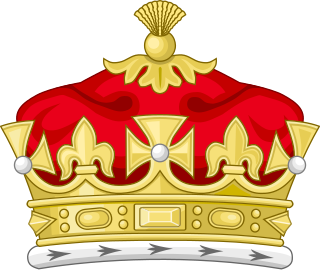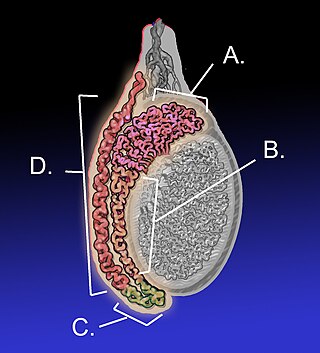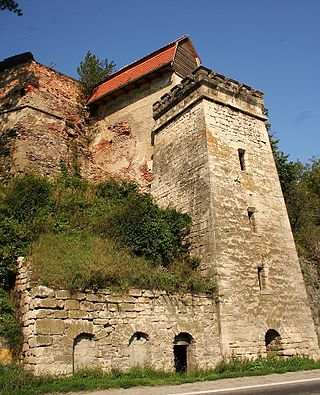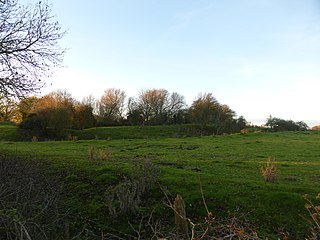Related Research Articles

Duke of Clarence was a substantive title created three times in the Peerage of England. The title Duke of Clarence and St Andrews has also been created in the Peerage of Great Britain, and Duke of Clarence and Avondale and Earl of Clarence in the Peerage of the United Kingdom. The titles have traditionally been awarded to junior members of the English and British royal family, and all are now extinct.
Per capita is a Latin phrase literally meaning "by heads" or "for each head", and idiomatically used to mean "per person". The term is used in a wide variety of social sciences and statistical research contexts, including government statistics, economic indicators, and built environment studies.

The epididymis is an elongated tubular structure attached to the posterior side of each one of the two male reproductive glands, the testicles. It is a single, narrow, tightly coiled tube in adult humans, 6 to 7 centimetres in length; uncoiled the tube would be approximately 6 m long. It connects the testicle to the vas deferens in the male reproductive system. The epididymis serves as an interconnection between the multiple efferent ducts at the rear of a testicle (proximally), and the vas deferens (distally). Its primary function is the storage, maturation and transport of sperm cells.

Caput medusae is the appearance of distended and engorged superficial epigastric veins, which are seen radiating from the umbilicus across the abdomen. The name caput medusae originates from the apparent similarity to Medusa's head, which had venomous snakes in place of hair. It is also a sign of portal hypertension. It is caused by dilation of the paraumbilical veins, which carry oxygenated blood from mother to fetus in utero and normally close within one week of birth, becoming re-canalised due to portal hypertension caused by liver failure.
Robert Fitz Richard (1064–1136) was an Anglo-Norman feudal baron of Little Dunmow, Essex and constable of Baynard's Castle in the City of London. His feudal barony, the caput of which was at Little Dunmow in Essex, was granted to him by the king after it had been forfeited in 1110 by William Baynard, whose grandfather Ralph Baynard was the first holder and the builder of Baynard's Castle in the City of London.

Boița is a commune in Sibiu County, Transylvania, Romania, at the foothills of the Cindrel Mountains, 22 km (14 mi) south of the county capital Sibiu, in the Mărginimea Sibiului ethnographic area, on the main road between Sibiu and the southern part of Romania, the National road 7/European route 81, at the entrance of the Olt River defile. The commune is composed of four villages: Boița, Lazaret, Lotrioara (Latorvár) and Paltin. These were part of Tălmaciu town until 2004, when they were split off.
Robert fitz Martin was a knight from Devon whose father, Martin de Turribus, was the first Norman Lord of Kemes, in what had previously been the Dyfed part of Deheubarth. Fitz Martin inherited the Lordship of Kemes from his father, and founded St Dogmaels Abbey c. 1118. He was the first of the FitzMartin line. His descendants continued to hold lands in England and Wales until the 14th century.

Kendal Castle is a medieval fortification to the east of the town of Kendal, Cumbria, in northern England. The castle, which is atop a glacial drumlin, was built in the 13th century as the Caput baroniae for the Barony of Kendal. By the 15th century, the Parr family owned the castle.

Neurotensin receptor type 2 is a protein that in humans is encoded by the NTSR2 gene.

In Norse mythology, Vili and Vé are the brothers of the god Odin, sons of Bestla, daughter of Bölþorn; and Borr, son of Búri.

In heraldry, an achievement, armorial achievement or heraldic achievement is a full display or depiction of all the heraldic components to which the bearer of a coat of arms is entitled. An achievement comprises not only the arms displayed on the escutcheon, the central element, but also the following elements surrounding it :

In the kingdom of England, a feudal barony or barony by tenure was the highest degree of feudal land tenure, namely per baroniam, under which the land-holder owed the service of being one of the king's barons. The duties owed by and the privileges granted to feudal barons are not exactly defined, but they involved the duty of providing soldiers to the royal feudal army on demand by the king, and the privilege of attendance at the king's feudal court, the Magnum Concilium, the precursor of parliament.

Macgowania is an extinct genus of parvipelvian ichthyosaur known from British Columbia of Canada.

The northern celestial hemisphere, also called the Northern Sky, is the northern half of the celestial sphere; that is, it lies north of the celestial equator. This arbitrary sphere appears to rotate westward around a polar axis due to Earth's rotation.
Caput is an extinct town in Barton County, in the U.S. state of Missouri. The town site is approximately five miles northwest of Lamar.
This article presents a timeline of the name Judea through an incomplete list of notable historical references to the name through the various time periods of the region.
The feudal barony of Dirleton was a feudal barony with its caput baroniae originally at Castle Tarbet, Elbottle Castle and later at Dirleton Castle in East Lothian, Scotland. The Lordship & Barony of Dirleton lay in East Lothian a few miles west of North Berwick, the land comprising the Caput of the Barony is today only a little over 40 acres, including the Island of Lamb, North and South Dogs in the east coast of Scotland. Its ruined castle, two triangular greens and the buildings are grouped in the traditional style of a medieval township. Dirleton Castle was built in the middle of the twelfth century by a branch of the Anglo-Norman family of De Vaux, a family with its origins in Rouen, Normandy, which had settled in Dirleton during the reign of King Malcolm IV (1153‒1165). The original castle was modelled on contemporary French castles, in particular Coucy la Chateaux north of Paris. Dirleton Castle was defended against the invading army of Edward I of England in June 1298, but eventually fell to Anthony Beck, the fighting Bishop of Durham. In 1311 the castle was recaptured by the Scots and Robert the Bruce ordered that it be reduced (ruined) to eliminate the possibility of it being occupied by the English in the future. Dirleton was in the hands of the De Vaux family for about two centuries.
Irthington Castle was a castle located near Irthington, Cumbria, England.

Folkingham Castle is located near the village of Folkingham, Lincolnshire, England. The castle was the caput baroniae of the barony of Folkingham.
Roberton Castle, was a 12th-century motte and bailey castle, constructed by Robert, brother of Lambin Asa, near Roberton, South Lanarkshire, Scotland.
References
- ↑ Michael Aston, Interpreting the Landscape (Routledge, reprinted 1998, page 34)
![]() This article incorporates text from a publication now in the public domain : Chambers, Ephraim, ed. (1728). "CAPUT: Caput Baroniæ". Cyclopædia, or an Universal Dictionary of Arts and Sciences . Vol. 1 (1st ed.). James and John Knapton, et al. pp. 156–7.
This article incorporates text from a publication now in the public domain : Chambers, Ephraim, ed. (1728). "CAPUT: Caput Baroniæ". Cyclopædia, or an Universal Dictionary of Arts and Sciences . Vol. 1 (1st ed.). James and John Knapton, et al. pp. 156–7.